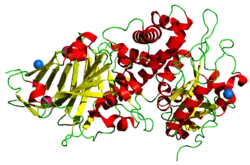Exotoxin A
Exotoxin A ist bekannt als ein bedeutendes, virulentes Lektin aus dem Bakterium Pseudomonas aeruginosa. Die Molekülmasse beträgt 66,5 kDa. Das Polypeptid Exotoxin A besteht aus drei Domänen, von denen eine ADP-Ribosyltransferase-Aktivität besitzt, während die beiden anderen Domänen das Toxin an sensitive Zellen binden und für das Eindringen der ersten Domäne in das Cytoplasma durch die Zellmembran hindurch verantwortlich sind.
| Exotoxin A (Pseudomonas aeruginosa) | ||
|---|---|---|
 | ||
| Bändermodell nach PDB 1IKQ in blau sind die Chlorid-, in pink die Natriumionen eingezeichnet | ||
| Masse/Länge Primärstruktur | 613 Aminosäuren | |
| Bezeichner | ||
| Gen-Name(n) | toxA (PseudoCAP) | |
| Externe IDs | ||
| Transporter-Klassifikation | ||
| TCDB | 1.C.73.1.1 | |
| Bezeichnung | Pseudomonas-Exotoxin-Familie | |
| Enzymklassifikation | ||
| EC, Kategorie | 2.4.2-, Transferase | |
| Reaktionsart | Übertragung eines ADP-Ribosylrests | |
| Substrat | EF-2 + NAD | |
| Produkte | defekter EF-2 | |
| Vorkommen | ||
| Übergeordnetes Taxon | Pseudomonas[1] | |
Das biochemische Verhalten ist identisch mit der Reaktion von Diphtherietoxin A, d. h. der Elongationsfaktor eEF-2 wird zu einem ADP-Ribosyl-EF2-Komplex gebunden und steht somit nicht mehr für die Proteinsynthese zur Verfügung.
Literatur
- S. P. Yates, P. L. Taylor, R. Jørgensen u. a.: Structure-function analysis of water-soluble inhibitors of the catalytic domain of exotoxin A from Pseudomonas aeruginosa. In: Biochem. J. 385 (Pt 3), Februar 2005, S. 667–675. doi:10.1042/BJ20041480. PMC 1134741 (freier Volltext). PMID 15458385.
- S. P. Yates, A. R. Merrill: Elucidation of eukaryotic elongation factor-2 contact sites within the catalytic domain of Pseudomonas aeruginosa exotoxin A. In: Biochem. J. 379 (Pt 3), Mai 2004, S. 563–572. doi:10.1042/BJ20031731. PMC 1224111 (freier Volltext). PMID 14733615.
- P. Hafkemeyer, U. Brinkmann, E. Brinkmann, I. Pastan, H. E. Blum, T. F. Baumert: Pseudomonas exotoxin antisense RNA selectively kills hepatitis B virus infected cells. In: World J. Gastroenterol. 14 (18), Mai 2008, S. 2810–2817. doi:10.3748/wjg.14.2810. PMC 2710720 (freier Volltext). PMID 18473403.
- Daniel Stuckey, Shawn Hingtgen, Nihal Karaka, Benjamin Rich, Khalid Shah: Engineering toxin-resistant therapeutic stem cells to treat brain tumors. In: Stem Cells (AlphaMed Express). 2, 2015, S. 589–600. doi:10.1002/stem.1874.
Einzelnachweise
This article is issued from Wikipedia. The text is licensed under Creative Commons - Attribution - Sharealike. The authors of the article are listed here. Additional terms may apply for the media files, click on images to show image meta data.